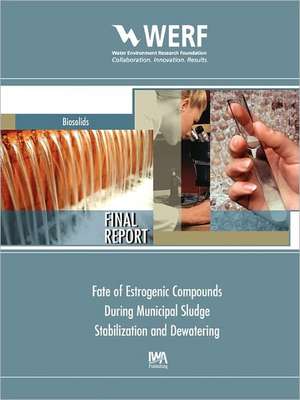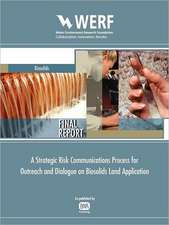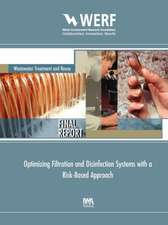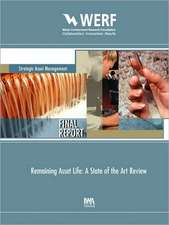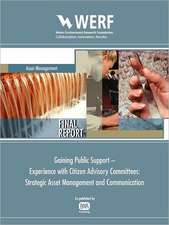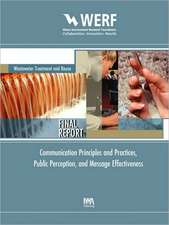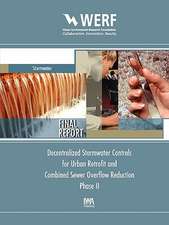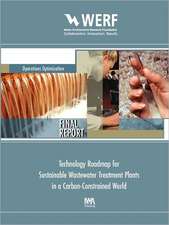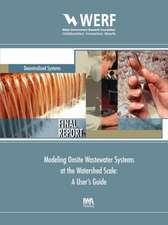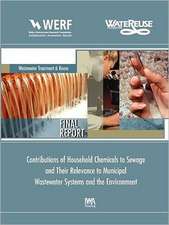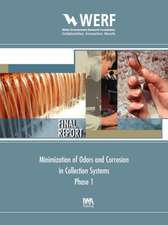Fate of Estrogenic Compounds During Municipal Sludge Stabilization and Dewatering: Werf Research Report
Autor Edward T. Furlong, Dave Quanrud, Beverley M. Stinsonen Limba Engleză Paperback – dec 2010
Din seria Werf Research Report
- 23%
 Preț: 838.43 lei
Preț: 838.43 lei - 23%
 Preț: 787.71 lei
Preț: 787.71 lei - 23%
 Preț: 785.57 lei
Preț: 785.57 lei - 23%
 Preț: 794.54 lei
Preț: 794.54 lei - 23%
 Preț: 794.07 lei
Preț: 794.07 lei - 23%
 Preț: 793.14 lei
Preț: 793.14 lei - 23%
 Preț: 961.96 lei
Preț: 961.96 lei - 23%
 Preț: 794.07 lei
Preț: 794.07 lei - 23%
 Preț: 813.50 lei
Preț: 813.50 lei - 23%
 Preț: 783.69 lei
Preț: 783.69 lei - 23%
 Preț: 812.10 lei
Preț: 812.10 lei - 23%
 Preț: 790.52 lei
Preț: 790.52 lei - 23%
 Preț: 797.16 lei
Preț: 797.16 lei - 23%
 Preț: 805.93 lei
Preț: 805.93 lei - 23%
 Preț: 789.58 lei
Preț: 789.58 lei - 23%
 Preț: 804.05 lei
Preț: 804.05 lei - 23%
 Preț: 799.55 lei
Preț: 799.55 lei - 23%
 Preț: 800.50 lei
Preț: 800.50 lei - 23%
 Preț: 791.72 lei
Preț: 791.72 lei - 23%
 Preț: 787.23 lei
Preț: 787.23 lei - 23%
 Preț: 798.57 lei
Preț: 798.57 lei - 23%
 Preț: 791.26 lei
Preț: 791.26 lei - 23%
 Preț: 804.52 lei
Preț: 804.52 lei - 23%
 Preț: 790.52 lei
Preț: 790.52 lei - 23%
 Preț: 799.55 lei
Preț: 799.55 lei - 23%
 Preț: 787.71 lei
Preț: 787.71 lei - 23%
 Preț: 850.28 lei
Preț: 850.28 lei - 23%
 Preț: 796.48 lei
Preț: 796.48 lei - 23%
 Preț: 795.27 lei
Preț: 795.27 lei - 23%
 Preț: 965.23 lei
Preț: 965.23 lei - 23%
 Preț: 976.62 lei
Preț: 976.62 lei - 23%
 Preț: 785.09 lei
Preț: 785.09 lei - 23%
 Preț: 970.20 lei
Preț: 970.20 lei - 23%
 Preț: 786.50 lei
Preț: 786.50 lei - 23%
 Preț: 795.95 lei
Preț: 795.95 lei - 23%
 Preț: 966.45 lei
Preț: 966.45 lei - 23%
 Preț: 796.48 lei
Preț: 796.48 lei - 23%
 Preț: 794.80 lei
Preț: 794.80 lei - 23%
 Preț: 958.87 lei
Preț: 958.87 lei - 23%
 Preț: 805.93 lei
Preț: 805.93 lei - 23%
 Preț: 806.40 lei
Preț: 806.40 lei - 23%
 Preț: 789.84 lei
Preț: 789.84 lei - 23%
 Preț: 792.19 lei
Preț: 792.19 lei - 23%
 Preț: 957.40 lei
Preț: 957.40 lei - 23%
 Preț: 796.68 lei
Preț: 796.68 lei - 23%
 Preț: 966.91 lei
Preț: 966.91 lei - 23%
 Preț: 964.77 lei
Preț: 964.77 lei - 23%
 Preț: 975.22 lei
Preț: 975.22 lei
Preț: 797.62 lei
Preț vechi: 1035.87 lei
-23% Nou
Puncte Express: 1196
Preț estimativ în valută:
152.66€ • 158.78$ • 127.93£
152.66€ • 158.78$ • 127.93£
Carte tipărită la comandă
Livrare economică 10-15 martie
Preluare comenzi: 021 569.72.76
Specificații
ISBN-13: 9781843393900
ISBN-10: 1843393905
Pagini: 140
Dimensiuni: 210 x 279 x 10 mm
Greutate: 0.41 kg
Editura: Water Environment Research Foundation
Seria Werf Research Report
ISBN-10: 1843393905
Pagini: 140
Dimensiuni: 210 x 279 x 10 mm
Greutate: 0.41 kg
Editura: Water Environment Research Foundation
Seria Werf Research Report
